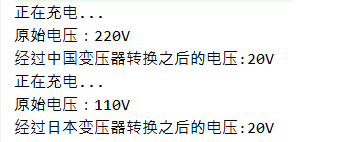定义
适配器模式(Adapter Pattern):将一个接口转换成客户希望的另一个接口,使接口不兼容的那些类可以一起工作,其别名为包装器(Wrapper)。适配器模式既可以作为类结构型模式,也可以作为对象结构型模式。
适用场景
1、 你想使用一个已经存在的类,而它的接口不符合你的需求 2、 你想创建一个可以复用的类,该类可以与其他不相关的类或不可预见的类(即那些接口不一定兼容的类)协同工作。 3、 (仅适用于对象Adapter)你想使用一些已经存在的子类,但是不可能对每一个都进行子类化以匹配它们的接口。对象适配器可以适配它的父类接口。
示例代码
/**
* 测试类
*
* @author Lenjor
* @version 1.0
* @date 2019-11-10 18:37
*/
public class Client {
public static void main(String[] args) {
Phone phone = new Phone();
ChinaAdapter adapter = new ChinaAdapter();
phone.setAdapter(adapter);
phone.charge();
JapanAdapter japanAdapter = new JapanAdapter();
phone.setJapanAdapter(japanAdapter);
phone.japanCharge();
}
}
/**
* 充电接口
*
* @author Lenjor
* @version 1.0
* @date 2019-10-03 23:14
*/
public interface Charge {
public int charge();
}
/**
* 中国充电适配器
*
* @author Lenjor
* @version 1.0
* @date 2019-11-10 18:38
*/
public class ChinaAdapter implements Charge {
private final static int INPUT = 220;
public int charge() {
System.out.println("正在充电...");
System.out.println("原始电压:" + INPUT + "V");
int output = INPUT - 200;
System.out.println("经过中国变压器转换之后的电压:" + output + "V");
return output;
}
}
/**
* 日本充电适配器
*
* @author Lenjor
* @version 1.0
* @date 2019-11-10 18:48
*/
public class JapanAdapter implements Charge{
private final static int INPUT = 110;
public int charge() {
System.out.println("正在充电...");
System.out.println("原始电压:" + INPUT + "V");
int output = INPUT - 90;
System.out.println("经过日本变压器转换之后的电压:" + output + "V");
return output;
}
}
/**
* 手机
*
* @author Lenjor
* @version 1.0
* @date 2019-11-10 18:38
*/
public class Phone {
private ChinaAdapter chinaAdapter;
private JapanAdapter japanAdapter;
public int charge () {
return chinaAdapter.charge();
}
public void setAdapter(ChinaAdapter adapter) {
this.chinaAdapter = adapter;
}
public int japanCharge () {
return japanAdapter.charge();
}
public void setJapanAdapter(JapanAdapter adapter) {
this.japanAdapter = adapter;
}
}
测试结果:

总结
适配器模式,简单来说就是转换器,当我们需要本来不兼容的两个类协同工作的时候,就可以采用适配器让两者联系起来,在适配器内部做转换,对用户来说是无感的,只需要根据场景使用对应的适配器即可。
